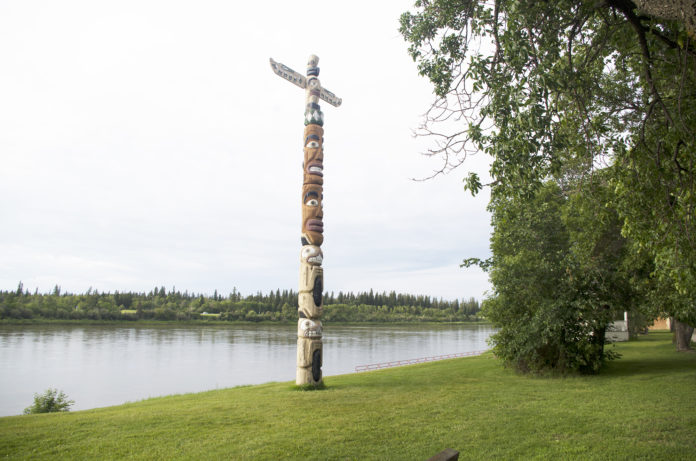
The riverbank totem pole located west of the Prince Albert Historical Museum has to come down, but it’s involved a long discussion over the best way to do it.
An inspection in 2017 revealed extensive rot along the structure’s base, which negatively affected its stability. Judy MacLeod Campbell, the City of Prince Albert’s Arts and Culture Coordinator, said the structure is in danger of falling over in strong winds.
The city plans to remove the totem pole and lay it to rest in the treed area near St. Mary’s graveyard and the Saskatchewan Penitentiary by the end of the year. However, there are questions about the best way to remove the totem pole, and what to do with it once it’s taken down.
“The cultural process for any work to be done to the totem poles needs to be determined by the carver themselves, or their descendants,” MacLeod Campbell told council during an executive committee meeting on July 22. “It’s not something we would just take upon ourselves to do, but we would check with the initial carver.”
James Sutherland and Dale Stonechild created and donated the totem pole to the City of Prince Albert in November 1975. Both men were Saskatchewan Penitentiary inmates at the time.
Recent searches for the duo have not been completely successful. MacLeod Campbell said they think Stonechild is incarcerated in British Columbia, and believe Sutherland has since passed away. Efforts to locate any surviving family have not been successful.
MacLeod Campbell said they’ve talked to local elders about removing the totem pole, but many declined to give any advice.
“They weren’t comfortable speaking about the protocol because it’s not part of the cultural traditions of First Nations people in this area,” she explained. “They couldn’t speak on that west coast practice.”
Instead, the city sought advice from experts at the University of British Columbia, who said totem poles are typically removed and buried instead of being repaired. McLeod Campbell said they’ve also spoken to representatives from the City of Kingston, who faced a similar dilemma with two totem poles that were also created and donated by inmates.
Kingston repaired one of those totem poles, and moved it to their penitentiary. MacLeod Campbell said they explored that option in Prince Albert, but rejected it on the advice of local elders.
A local Prince Albert Historical Society knowledge keeper also contacted a cultural protocol expert on the National Museum of Nature Board, who advised the city to bury the totem pole, and document its story.
There are no formal plans for replacing the totem pole with another piece of public art, although elders said they’d like a piece of local Indigenous art to replace it.
Correction: a previous version of this article incorrectly stated that the totem pole would be buried after being removed. The Daily Herald apologizes for the error.

